Soccer goalkeeper training drills are essential for developing reflexes, agility, and decision-making․ The Soccer Goalkeeper Training Manual offers comprehensive PDF guides covering key techniques and game situations effectively․
Importance of Goalkeeper Training in Soccer
Importance of Goalkeeper Training in Soccer
Goalkeeper training is crucial for team success, as it directly impacts defensive stability and overall performance․ Goalkeepers are the last line of defense, requiring specialized skills like reflexes, positioning, and decision-making․ Proper training enhances their ability to handle high-pressure situations, such as one-on-one encounters and cross deliveries․ Effective drills, as outlined in resources like The Soccer Goalkeeper Training Manual, focus on agility, diving techniques, and ball distribution․ Developing these skills ensures goalkeepers can adapt to modern soccer demands․ A well-trained goalkeeper not only prevents goals but also acts as a playmaker, contributing to team cohesion․ Regular, structured training programs are essential for building confidence and consistency, making goalkeepers indispensable assets to any squad․
Overview of Key Skills for Goalkeepers

Overview of Key Skills for Goalkeepers
Goalkeepers require a diverse set of skills to excel in their role․ Reflexes and quick reactions are vital for making split-second saves․ Strong positioning and spatial awareness enable them to anticipate opponents’ moves effectively․ Footwork and agility drills improve their ability to cover the goalmouth and change direction rapidly․ Ball handling and catching techniques ensure reliability in securing the ball, reducing errors․ Distribution skills, such as accurate throwing and kicking, are essential for launching counterattacks․ Additionally, communication and leadership are critical for organizing the defense and directing teammates․ Mastery of these skills, as outlined in resources like The Soccer Goalkeeper Training Manual, transforms goalkeepers into confident, reliable, and commanding figures on the field․
Foundational Skills for Goalkeepers
Foundational skills for goalkeepers include proper footwork, ball control, and stance․ These basics form the backbone of advanced techniques and ensure effective performance in all situations․
Agility and Footwork Drills
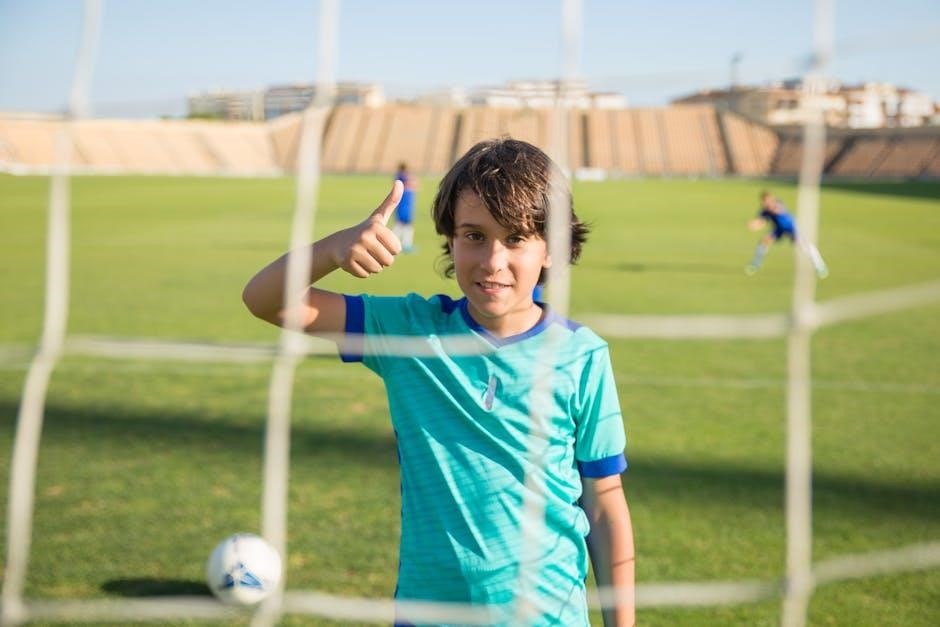
Agility and Footwork Drills
Agility and footwork are fundamental for goalkeepers to navigate the penalty area effectively․ Drills such as side shuffling, quick turns, and carioca drills enhance lateral movement and balance․ These exercises improve reaction time and coordination, allowing keepers to cover angles swiftly․ Footwork patterns like zigzag runs and cone weaving also strengthen agility․ Incorporating these drills into daily training ensures goalkeepers can move explosively and maintain proper positioning during matches․ Combining footwork with ball control exercises further develops the ability to transition from defense to distribution seamlessly․ Consistent practice of these drills builds the foundation for advanced techniques and ensures goalkeepers are always prepared to perform at their best․ Regular incorporation of agility drills is essential for long-term development and peak performance․
Reflexes and Reaction Training
Reflexes and Reaction Training
Reflexes and reaction training are crucial for goalkeepers to excel in high-pressure situations․ Drills like rapid-fire shots from varying angles and distances improve shot-stopping instincts․ Reaction box exercises, where goalkeepers respond to visual cues, enhance decision-making speed․ Tippi-tap drills with small balls simulate unpredictable game scenarios, refining hand-eye coordination․ Incorporating explosive plyometric movements, such as box jumps, boosts power for quick reactions․ These exercises train goalkeepers to anticipate and respond effectively to crosses, breakaways, and sudden shots․ Consistent practice of these drills ensures sharper reflexes and faster reactions, enabling goalkeepers to make split-second saves and dominate their box confidently․ Reflex training is foundational for building a reliable and commanding presence in goal․ Regular incorporation into training routines is vital for continuous improvement․
Ball Handling and Catching Techniques
Ball handling and catching techniques are fundamental for goalkeepers to securely control and distribute the ball․ Proper grip techniques, such as the W-grip, Hi-grip, and M1-grip, ensure stability when catching․ Tiki-taka drills with small balls enhance precision and quick handling․ Footwork integration, like shuffling and carioca drills, improves positioning and balance․ Drills involving high balls and crosses simulate game scenarios, teaching goalkeepers to judge flight and timing․ Consistent practice of these techniques builds confidence and reduces errors․ Incorporating variations, such as catching with different body parts, adds versatility․ Effective ball handling and catching are critical for maintaining possession and organizing plays․ These drills are essential for developing a goalkeeper’s ability to command the box and distribute the ball effectively․ Regular practice ensures mastery of these core skills․
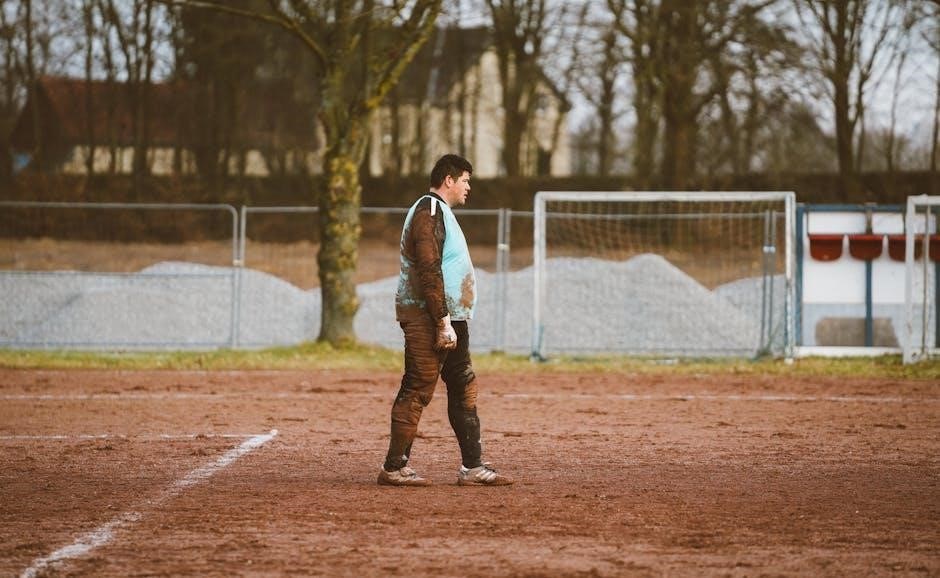
Advanced Goalkeeper Drills
Advanced drills focus on diving, positioning, and distribution techniques․ Goalkeepers refine their reflexes and precision through dynamic exercises, enhancing their ability to perform under pressure in high-stakes situations effectively․
Diving and Saving Techniques
Diving and saving techniques are critical for goalkeepers to master․ These drills focus on improving reflexes, timing, and body positioning to make precise saves․ Goalkeepers practice various types of dives, such as lateral and forward dives, to cover different angles․ Drills like the “reaction save” and “diving to the ground” simulate game-like scenarios, helping keepers develop explosive movements and quick recoveries․ Emphasis is placed on proper landing techniques to prevent injuries․ Advanced drills incorporate multiple shooters and dynamic ball movements to test a goalkeeper’s ability to read the game and anticipate shots․ These exercises build confidence and enhance a goalkeeper’s ability to perform under pressure․ Resources like The Soccer Goalkeeper Training Manual provide detailed guides for refining these skills effectively․
Narrowing the Angle and Positioning
Narrowing the angle and positioning are vital techniques for goalkeepers to control the space between themselves, the ball, and the goal․ Drills focus on footwork and body alignment to reduce scoring opportunities․ Goalkeepers learn to position themselves dynamically, staying between the ball and the goal while maintaining balance․ Advanced drills incorporate moving shooters and varying angles to simulate real-game scenarios․ These exercises enhance a goalkeeper’s ability to anticipate and react effectively․ Proper positioning not only minimizes the shooter’s options but also allows for quicker reactions to shots․ Resources like training manuals and online guides provide detailed drills to master these skills, ensuring goalkeepers can adapt to different situations and maintain defensive control․
Distribution and Kicking Drills
Distribution and kicking drills are crucial for goalkeepers to restart play effectively and maintain possession․ These exercises focus on accuracy, power, and decision-making when distributing the ball․ Goalkeepers practice short and long goal kicks, throw-outs, and punts to target teammates or open spaces․ Drills involve varying distances and angles, simulating game scenarios․ Accuracy drills include hitting targets or specific zones on the field․ Kicking for distance and precision helps goalkeepers launch counterattacks quickly․ These drills enhance a goalkeeper’s ability to transition from defense to offense seamlessly․ PDF guides like The Soccer Goalkeeper Training Manual provide structured drills to improve distribution skills, ensuring goalkeepers can contribute to both defense and attack effectively․

Specialized Training Drills
Specialized drills focus on advanced techniques like one-on-one situations, cross catching, and high-ball claiming․ These exercises simulate real-game challenges, enhancing decision-making and composure under pressure, as detailed in The Soccer Goalkeeper Training Manual PDF․
One-on-One and Breakaway Situations
Mastering one-on-one and breakaway situations is critical for goalkeepers․ These high-pressure scenarios demand quick reflexes, sharp decision-making, and precise positioning․ Drills such as rapid shot stopping, angled approaches, and recovery saves help goalkeepers develop the confidence to confront attackers effectively․ Coaches can simulate game-like conditions by incorporating variable speeds and unpredictable ball movements․ Goalkeepers should focus on staying low, reading body language, and using their body to narrow the shooter’s angle․ The Soccer Goalkeeper Training Manual provides detailed exercises to refine these skills, ensuring keepers are prepared for the most challenging moments in a match․ Regular practice and repetition are key to building composure and instinctive reactions in these situations․
Cross and High Ball Catching Drills
Cross and high ball catching are vital skills for goalkeepers to master․ Drills involving crosses from the wings simulate match scenarios, testing a goalkeeper’s ability to position themselves, time jumps, and secure the ball․ Techniques such as the “W” catch and body positioning under the ball are emphasized to ensure clean catches․ Coaches often combine these drills with footwork exercises to enhance agility and reaction speed․ Soccer Goalkeeper Training Manual highlights the importance of handling high crosses and using both hands effectively․ These drills are designed to build confidence and consistency, reducing the likelihood of errors during critical moments in a game․ Regular practice ensures goalkeepers are adept at managing aerial threats and organizing their defense effectively․
Communication and Organization Exercises
Communication and organization are critical for goalkeepers to direct their team and maintain defensive structure․ Drills focus on vocal commands, such as shouting coordinates for defensive lines and directing teammates during set-pieces․ Goalkeepers practice organizing wall positioning and ensuring clarity in instructions․ Exercises like 11v11 scrimmages incorporate these skills, simulating game scenarios where clear communication is vital․ Goalkeeper Training Manual emphasizes the importance of being the “voice” of the team․ These drills enhance leadership and decision-making, ensuring the goalkeeper acts as the last line of defense and a proactive organizer․ Effective communication boosts team confidence and reduces errors, making it a cornerstone of successful goalkeeping․
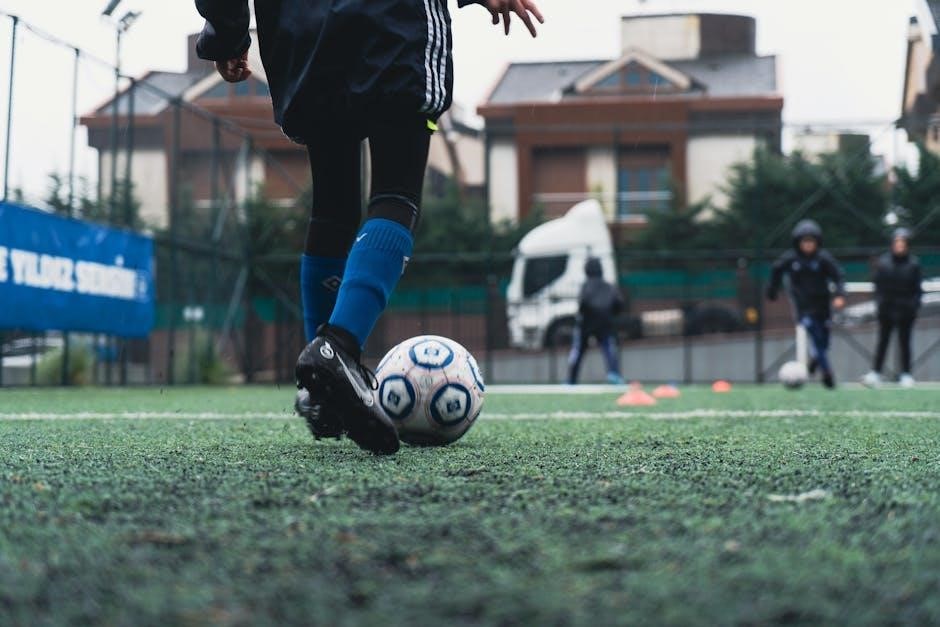
Training Program Development
Developing a goalkeeper training program requires a structured weekly schedule balancing technique drills, strength, conditioning, and mental preparation for enhanced performance and match readiness․
Creating a Weekly Training Schedule
Creating a Weekly Training Schedule
A well-structured weekly training schedule is crucial for goalkeepers to progressively improve their skills․ Start with Monday focusing on agility and footwork drills, followed by Wednesday dedicated to reflex and reaction training․ On Friday, incorporate game scenario simulations to mimic real match situations․ Include rest days to allow recovery and avoid injury․ Each session should balance technique, strength, and mental preparation․ Use PDF guides like The Soccer Goalkeeper Training Manual for detailed drills and progress tracking․ Ensure each day builds on the previous, keeping goalkeepers engaged and focused on continuous improvement․ A consistent schedule helps in mastering skills and adapting to the demands of the game effectively․
Incorporating Strength and Conditioning
Incorporating Strength and Conditioning
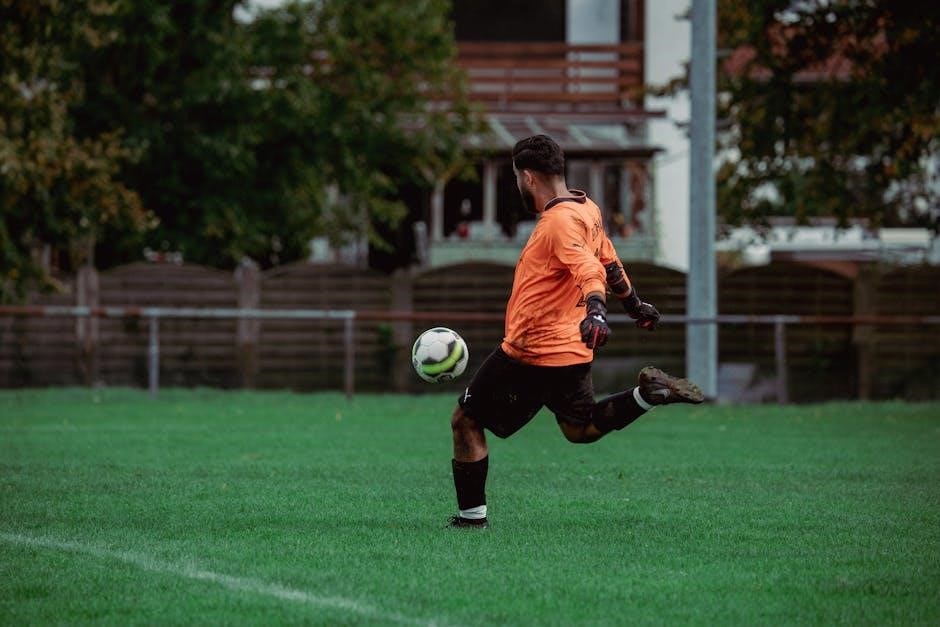
Incorporating strength and conditioning into goalkeeper training is vital for enhancing power, agility, and endurance․ Focus on exercises like plyometric drills and core strengthening to improve explosiveness and stability․ Leg strength is particularly important for diving and kicking, while flexibility exercises prevent injuries․ Use resistance bands or weights to build muscle endurance․ Many soccer goalkeeper training drills PDFs, such as The Soccer Goalkeeper Training Manual, include detailed strength routines tailored for goalkeepers․ Ensure strength training is balanced with technical drills to maintain coordination and agility․ A well-rounded conditioning program not only boosts physical performance but also enhances mental resilience, preparing goalkeepers for the demands of competitive matches․ Consistency in strength training is key to long-term development and peak performance․
Mental and Tactical Preparation
Mental and tactical preparation is crucial for goalkeepers to excel in high-pressure situations․ Focus on decision-making drills that simulate game scenarios, enhancing the ability to read plays and anticipate opponents’ moves․ Visualization exercises and mindfulness practices can improve focus and composure․ Tactical awareness, such as understanding positioning and organizing the defense, is vital․ Incorporate small-sided games to practice communication and leadership․ Many soccer goalkeeper training drills PDFs emphasize mental preparation, offering exercises to build confidence and strategic thinking․ A well-prepared goalkeeper not only saves shots but also directs the team effectively, making mental and tactical training indispensable for success․
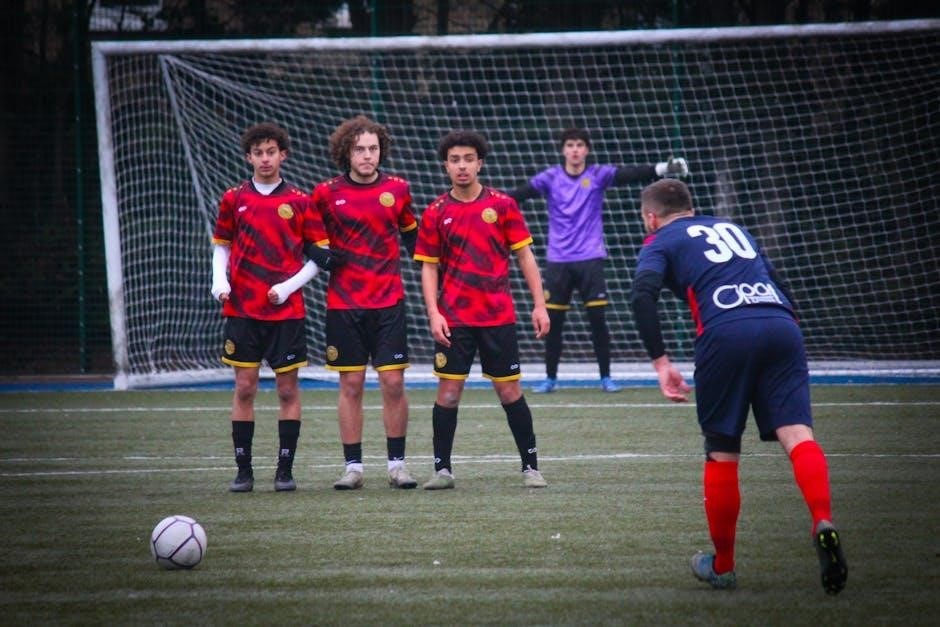
Resources for Goalkeeper Training
Discover top soccer goalkeeper training drills PDFs, such as The Soccer Goalkeeper Training Manual and Goalkeeper-Training-Program-Contents, offering detailed drills for reflexes, distribution, and diving techniques effectively․
Best PDF Guides for Goalkeeper Drills
Best PDF Guides for Goalkeeper Drills
Top-rated PDF guides like The Soccer Goalkeeper Training Manual and Goalkeeper-Training-Program-Contents provide detailed drills for improving reflexes, diving, and distribution․ These resources include step-by-step instructions, focusing on agility, footwork, and game-specific scenarios․ The Soccer Goalkeeper Training Manual emphasizes narrowing angles and handling high balls, while Goalkeeper-Training-Program-Contents offers 10 chapters with 10 drills each, covering foundational to advanced skills․ Both guides are designed for coaches and players, ensuring comprehensive development․ They are indispensable tools for structured and effective goalkeeper training, catering to all skill levels and ages․ These PDFs are widely recommended for their clear, actionable content․
Online Platforms for Training Materials
Online Platforms for Training Materials
Online platforms like UEFA․com and Football DNA offer extensive resources for soccer goalkeeper training․ These platforms provide downloadable PDF guides, video tutorials, and interactive drills tailored for goalkeepers․ UEFA․com features expert insights and training methods from top European coaches, while Football DNA focuses on modern techniques and adaptive drills․ Additionally, platforms like Tactics Manager allow coaches to create custom training sessions and share them with players․ These digital tools ensure access to high-quality, up-to-date training materials, making it easier for goalkeepers to improve their skills․ They cater to both youth and professional levels, offering a versatile approach to goalkeeper development․ These resources are widely praised for their practicality and effectiveness in enhancing performance․
Using Technology for Enhanced Training
Using Technology for Enhanced Training
Technology has revolutionized soccer goalkeeper training by providing innovative tools for skill development․ Video analysis software, such as Hudl and Dartfish, allows goalkeepers to review their performance and refine techniques․ Wearable devices like GPS trackers and smart gloves monitor movement and provide real-time feedback․ Additionally, apps and platforms like Tactics Manager enable coaches to design and share custom drills, focusing on specific skills like reflexes and positioning․ Virtual reality (VR) simulations are also emerging, offering immersive training experiences that mimic game scenarios․ These technological advancements ensure goalkeepers can train more effectively, track progress, and adapt to modern game demands․ They complement traditional drills and elevate the quality of training for both youth and professional keepers․
Consistent practice and dedication are key to mastering soccer goalkeeper drills; Utilize the Soccer Goalkeeper Training Manual PDF for structured, effective skill development and game readiness․
Final Tips for Effective Goalkeeper Training
Final Tips for Effective Goalkeeper Training
Consistency is key to improving goalkeeper skills․ Incorporate footwork, agility, and reflex drills into daily routines․ Practice game-like scenarios to enhance decision-making and positioning․ Review match footage to identify areas for improvement․ Mental toughness and clear communication are equally important as physical skills․ Encourage goalkeepers to stay focused and adaptable during high-pressure situations․ Strength and conditioning exercises should complement technical training․ Utilize resources like the Soccer Goalkeeper Training Manual PDF for structured drills and progress tracking․ Coaches should provide personalized feedback to help goalkeepers grow․ Remember, effective training is a balance of technique, physical fitness, and mental preparation․ Keep sessions engaging and challenging to foster continuous development․
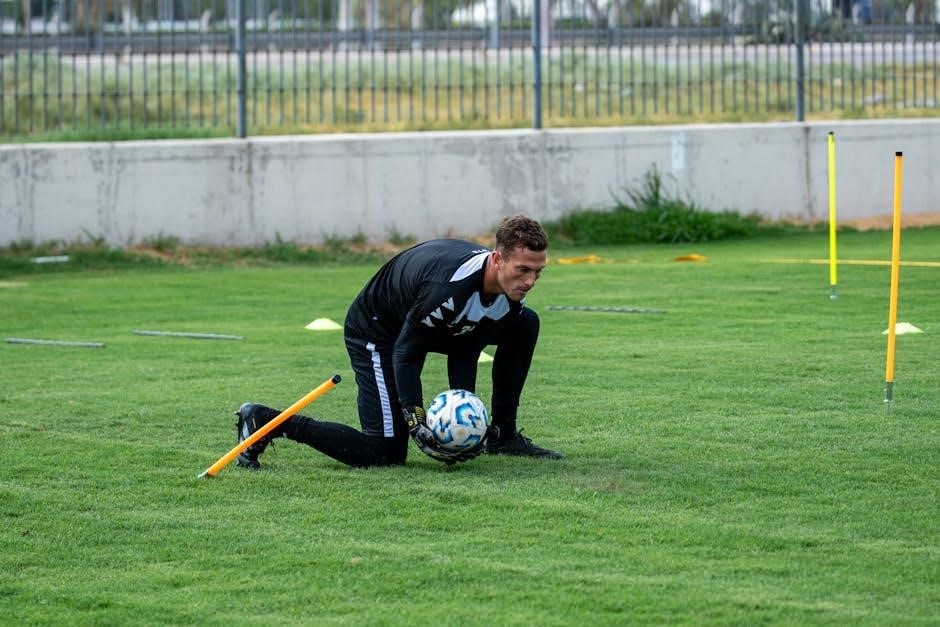
Continuous Improvement and Adaptation
Continuous Improvement and Adaptation
Continuous improvement is vital for goalkeepers to stay competitive․ Regularly adapt training drills to match evolving game demands and individual progress․ Incorporate feedback from coaches and self-review to refine techniques․ Stay updated with modern training methods and technologies, such as video analysis, to enhance performance․ Goalkeepers should embrace a growth mindset, focusing on weaknesses and building strengths․ Adaptability in high-pressure situations is crucial, as positions and strategies constantly change․ Utilize resources like the Soccer Goalkeeper Training Manual PDF to explore advanced drills and strategies․ Coaches play a key role in tailoring sessions to meet the unique needs of each goalkeeper․ Continuous learning and adaptation ensure long-term success and peak performance in the sport․
